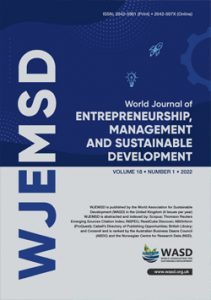Youth employment in Ghana: economic and social development policies perspective, Emmanuel Jumpah, Richard Ampadu-Ameyaw and Johnny Owusu-Arthur
 Emmanuel Tetteh Jumpah, Richard Ampadu-Ameyaw, Johnny Owusu-Arthur
Emmanuel Tetteh Jumpah, Richard Ampadu-Ameyaw, Johnny Owusu-Arthur
AMED, CSIR-STEPRI, Accra
Ghana
Email: emmanuel.jumpah@gmail.com
DOI: 10.1108/WJEMSD-07-2019-0060
Purpose: Creating employment opportunities for the youth remains a dilemma for policymakers. In many cases, policies and programmes to tackle youth unemployment have produced little results, because such initiatives have failed to consider some fundamental inputs. In Ghana, youth unemployment rate has doubled or more than doubled the national average unemployment rate in recent years. The current study, therefore, examines how policies in the past two decades have affected youth unemployment rate and other development outcomes.
Design/methodology/approach: The study reviewed national economic development policy documents from 1996 to 2017 and other relevant policies aimed at creating employment opportunities for the youth, applying the content analysis procedure. Four main policy documents were reviewed in this regard. Data from secondary sources including International Labour Organisation (ILO), World Bank (WB), United Nations Development Programme (UNDP) and Ghana Statistical Service (GSS) were analysed to examine the trends in youth unemployment rate, human development index and GDP growth rate in Ghana over the years. There were also formal and informal consultations with youth and development practitioners.
Findings: The results of the study show that policies that promote general growth in the economy reduce youth unemployment, while continuation of existing youth programmes, expansion, as well as addition of new ones by new governments reduces youth unemployment rate. In particular, GDP growth and youth unemployment rate trend in opposite direction; periods of increased growth have reduced youth unemployment rate and vice versa. The period of Ghana Shared Growth and Development Agenda I & II witnessed better reduction (5.7%) in youth unemployment rate than any of the policy periods. This was not sustained, and despite the current youth employment initiatives, unemployment among young people still remained higher than the national average.
Research limitations/implications: The study provides relevant information on how development policies and programmes affect youth unemployment rate over time. In as much as it is not the interest of the study, the study stops short of empirical estimation to determine the level of GDP growth rate that can reduce a particular level of youth unemployment, which is a case for further research. Nevertheless, the outcome of the study reflects the data and methodology used.
Originality/value: To the best of the knowledge of the authors, this is a first study in Ghana that has attempted to directly link development outcomes such as youth unemployment to national economic development policies, although there are studies that have analysed the policy gaps and implementation challenges. This paper, therefore, bridges the knowledge of how development policies affect youth employment opportunities, particularly for Ghana.
Keywords: Employment; Youth; Development; Policy; Ghana; Unemployment.
Citation: Jumpah, E.T., Ampadu-Ameyaw, R. and Owusu-Arthur, J. (2020), "Youth employment in Ghana: economic and social development policies perspective", World Journal of Entrepreneurship, Management and Sustainable Development, Vol. 16 No. 4, pp. 413-427. https://doi.org/10.1108/WJEMSD-07-2019-0060

